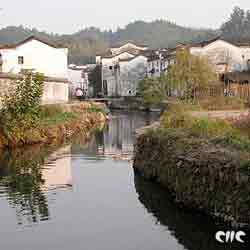
This is about the best time to visit Wuyuan in southeast China's Jiangxi Province, when a trek in the old villages in May offers refreshing views of hills covered in yellow rape flowers, green farmland, exuberant camphor trees, creeks and small rapids. Villages lie along small rivers, trees stand on riverbanks, and old farmers leisurely drive ducks toward a pond, forming a typical Chinese countryside scene.
Wuyuan has at least 50 old villages that have remained almost unchanged over the last century. However, it is known not only for its natural scenery, but also for its glorious past. The remote county was home to some of China's top scholars, including Zhu Xi, a Confucian master in the Southern Song Dynasty (1127-1279), and Zhan Tianyou, China's first railway engineer. It also produced some of the country's richest merchants.
The county's glorious past can still be found in its uniquely-built houses, most of which, big or small, feature white walls, black roofs, elegant eaves, and dark green footstones.
Merchants from Huizhou, an ancient prefecture Wuyuan belonged to, together with those from north China's Shanxi Province, dominated China's business field for about 500 years until the end of the Qing Dynasty (1644-1911). These merchants attached importance to education. They were more proud of their education than their wealth, because in feudal dynasties, passing imperial civil service examinations was the only way to enter the highest social stratum of government officials.
Huizhou had six counties, but the Huizhou relics are best kept in Wuyuan, partly because Wuyuan is remote, and partly because Wuyuan people tried hard to protect them in time of ups and downs.
Getting there: First take a train to Jingdezhen, and then transfer to Wuyuan by bus. Train K45 from Beijing to Fuzhou starts at 10:08 AM that arrives at Jingdezhen at 8:20 AM next day. Buses from Jingdezhen to Wuyuan are available daily from 6:30 AM to 4:20 PM. If you plan to visit Wuyuan only, be sure to buy the return train (K46, 7:21 AM from Jingdezhen) ticket on the day you arrive at Jingdezhen.
Duration: It is advisable to spend two to three days in the villages of Wuyuan, the best way to savour the grand view of China's most beautiful countryside and the serenity of rural life. That means you will have to spare at least one week for the trip. If you have some extra days, a trip to the nearby Yellow Mountain (Huangshan) is strongly recommended. There is a direct bus from Wuyuan to the city of Huangshan.
Cost: Around 1,500 yuan (US$180) per person to cover transportation (hard sleepers and buses) and basic accommodation for the recommended itinerary: Beijing-Jingdezhen-Wuyuan, Jingdezhen-Beijing.
(China Daily April 21, 2006)
|

